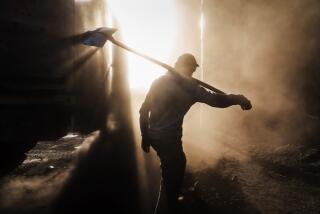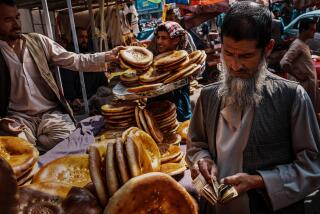U.S. Bombers Pound Al Qaeda Mountain Lair
- Share via
KABUL, Afghanistan — U.S. bombers hammered Al Qaeda positions deep in the mountains of eastern Afghanistan for a second day Sunday after an attempted ground assault on the area was repulsed.
The ongoing attack--which U.S. officials say is the largest joint ground offensive of the war, involving hundreds of Afghan government soldiers as well as U.S. troops--is encountering heavy resistance from Al Qaeda and Taliban fighters.
The Al Qaeda forces have fortified their positions in the rugged mountains and cave complexes in Paktia province, south of Kabul, the Afghan capital, according to local commanders and Afghan intelligence sources.
No major ground action was reported Sunday. One Afghan commander said that the Americans had shifted their strategy after encountering heavy resistance from the Al Qaeda troops.
“Americans wanted to start with a ground attack, but as soon as they had casualties they changed their mind and they’ve just been bombing,” said Wazir Khan, who is helping to lead a 600-man contingent that is attacking the hide-out from the south.
At least one U.S. soldier and five Afghans died during the first day of fighting. Officials at U.S. Central Command in Tampa, Fla., said in a written statement Sunday that “an unspecified number of U.S. and Afghan forces have been injured.” The U.S. officials described all of the American injuries as “non-life-threatening.”
Residents of Gardez, the city nearest to the fighting, could see streams of black smoke rising from snowy mountains and hear the constant drone of bombers overhead.
According to the Central Command statement, no American aircraft had been shot down, although some AH-64 Apache helicopters were damaged by enemy fire. The statement said that, from 6:30 a.m. Afghan time Saturday through Sunday, “more than 270 bombs have been dropped in support of Afghan, U.S. and coalition forces.”
Targets have included enemy troops, caves, vehicles, mortars and antiaircraft artillery sites. Among the coalition nations participating in the fighting near Gardez are Norway, Germany, Canada, Australia, France and Denmark, the statement said.
It is uncertain how many Al Qaeda and Taliban fighters are hidden in the mountain region. The area is large, and some estimates before the fighting began put the figure at about 600. But Sunday, some people were saying there could be as many as 2,000, Wazir Khan said. The cave complex where they are hiding was built during the Afghans’ war against Soviet occupation in the 1980s.
The Central Command reiterated its estimate that the enemy force near Gardez was made up of “several hundred” fighters. Speaking on condition of anonymity, one defense official said that the Pentagon believed the enemy fighters near Gardez were the last major pocket of Al Qaeda holdouts in Afghanistan. Smaller pockets, he said, probably remain elsewhere.
The American death was the second during the war attributed to hostile fire. Wazir Khan said that the U.S. soldier was hit by a mortar shell as he drove a pickup close to the front lines.
“Bombing has been going on very heavily,” he said.
The area, known as Shahi Kot, has been under surveillance by Americans since early January, and they approached it several times after reports that Taliban and Arab fighters were massing there, an Afghan Interior Ministry official said in a recent interview.
Al Qaeda and Taliban fighters hiding in Shahi Kot are being protected by several former high-ranking Taliban ministers and commanders, including Saiful Rahman, Maulvi Mansour and Qabir, the ministry official said. A key Arab leader in the area is Abu Abdullah, he said, describing the group as well-armed with shoulder-launched Stinger missiles, mortars and cannons.
Neither the Taliban’s supreme leader, Mullah Mohammed Omar, nor Al Qaeda chief Osama bin Laden was believed to be in the area.
As fighting continued, an earthquake with a magnitude of 7.2 at its epicenter in the Hindu Kush mountains shook Kabul about 4:40 p.m. local time Sunday. Concrete buildings swayed, some brick and mud structures crumbled, and people ran into the streets.
There were conflicting reports about casualties, but at least two people--an older man and an infant--appear to have been crushed when brick walls fell on them.
Because Kabul has been ravaged by war, determining which buildings were damaged by the quake and which were victims of two decades of civil strife was difficult.
In the old neighborhoods of Kabul, where there are a number of inhabited--although only half-standing--buildings, brick walls tumbled in heaps, and concrete walls cracked and fell, crushing small shops beneath them. Completely demolished, for instance, was a secondhand tin shop owned by Abdul Aziz, who rushed to the middle of the street when the earthquake struck because his one-room store was surrounded by already half-fallen buildings. He left not a moment too soon.
“My shop is gone, completely destroyed now,” he said, pointing at the shop’s roof. It had been crushed by a concrete slab falling from a nearby building.
*
Times staff writers David Willman and John Hendren in Washington contributed to this report.
More to Read
Sign up for Essential California
The most important California stories and recommendations in your inbox every morning.
You may occasionally receive promotional content from the Los Angeles Times.













